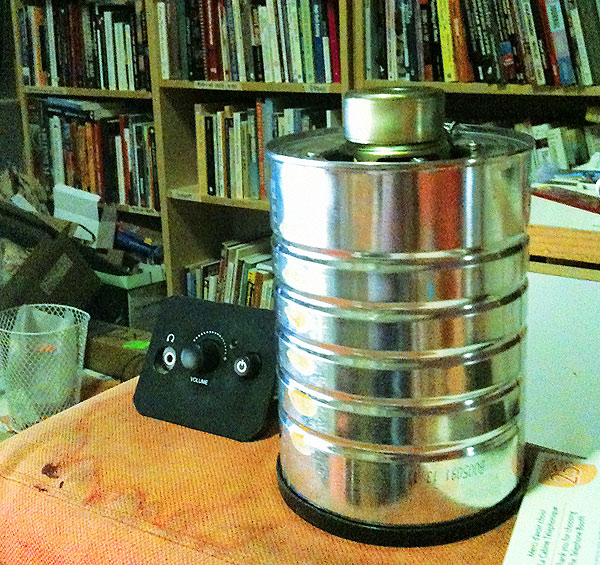Something like a year ago I took the $10 speakers that I had loaned Caitlin and started cutting them up for a project. Half way through I discovered that not only was it going to be difficult to disentwine the cables and controls from holes in the plastic case, but to make matters much worse, the jackass “if it breaks, buy a new one” manufacturer had filled the guts of the speaker with hot glue, covering all the fine cables and electronics. This afternoon I finally picked it up again, and slowly ground away the case bit by bit, and then carefully went at the glue — I felt like an archaeologist clearing a dinosaur fossil — finally getting me a minimal pile of pieces that had suffered a minimal amount of damage (which tested my mediocre soldering skills but I just barely passed). All I’ve done for now is mount them in coffee cans (which wounds surprisingly improved, and can be set up with a variety of EQ-like effects by whether you have the lid on and how you orient the can), but maybe I’ll get more ambitious later.
I read somewhere lately that in the “olden days”, when you’d buy an appliance the manual would contain plenty of technical reference, component listings, schematics and exploded view diagrams, and so on… This is of course a rarity today and I can’t think of a single modern example other than a few things in the open source world (like Arduinos) which arguably doesn’t count. Anyway, I don’t know if I’m going to boycott products without manuals, but do you really have to spray the innards with glue to make me repairing or modifying my own property difficult? It’s like some sort of preemptive vandalism.




9 Comments
Indeed. My dryer here (quite old, but dryer technology hasn’t really changed in ages) has a full schematic with it, which came in quite handy when I was diagnosing a short.
From the look of it, I estimate the dryer to probably be from the late 70s-mid 80s.
Phil
You rarely find good technical documentation anymore, it’s true.
I say that as someone who writes manuals for a living. Mine are awesome, of course.
I hate the throw it away mentality. I like to have things grow old with me if I can. Theres nothing better than a tool or piece of equipment that youve had for yrs.
DIY rules!
That’s a big transformer for those small speaker drivers, no? Was that the entirety of the integrated amplifier-speaker enclosure?
I recall looking at the manual for my Dad’s 1973 Lotus Eclat, and comparing it to the manual for the car I had at the time, a 1998 Volkswagen Jetta. The Lotus manual told you how to do just about everything, the Jetta manual honestly said, to change the bulbs in the headlights, take it to the dealership!
This is all too true.
Years ago, when I bought a piece of electronic equipment, I’d get a proper handbook with detailed instructions, technical specs and a circuit diagram. Now, it’s a 60-page “userguide”, written in 30 different languages, with 2 pages in fractured English which don’t tell you much more than where the on/off switch is.
There’s an annoying insistence on only “qualified service personnel” being able to attempt a repair (the cost of which will invariably make it uneconomic), coupled with a fear of being sued if the user mis-reads the instructions and either wrecks the thing or causes an accident.
Here is a project for building a little solar powered ROBOT. If you take the time to get your kid into it in a few years he or she can found a toy company (or NOT).
1./ figure out how to get the motors out of electric toothbrushes (ask your friends to give you their old brushes instead of throwing them away).
2./ old cassette players are a good source of wheels that you (your child) can make into a little car which can be powered by a battery the right size for the electric tooth brush motor.
3. the above skills mastered you’ll next combine a little solar panel (cast off hand calculators have little panels) with a capacitor and a diode that fires when the capacitor is charged.
4. These little gadgets your child has made will come alive in sunlight as the capacitor charges and fires.
5. There are simple tricks you or rather he or she can learn so that the robot can reverse and turn when it hits something.
6. This is how and why Shannon was able to do the things he did such as SciFAX.
===============================
THINK ABOUT IT. Home schooling at its best is not lecturing your kids it is more a setting them free but not exactly.
At the time it looked to some like slavery and oppression
and it was
but it was not
it was what we all had to do
words fail me
Post a Comment